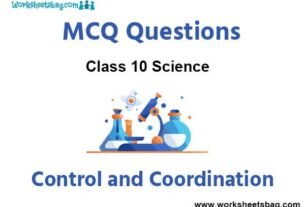Please refer to Electricity MCQ Questions Class 10 Science below. These MCQ questions for Class 10 Science with answers have been designed as per the latest NCERT, CBSE books, and syllabus issued for the current academic year. These objective questions for Electricity will help you to prepare for the exams and get more marks.
Electricity MCQ Questions Class 10 Science
Please see solved MCQ Questions for Electricity in Class 10 Science. All questions and answers have been prepared by expert faculty of standard 10 based on the latest examination guidelines.
MCQ Questions Class 10 Science Electricity
Question: Three resistances of 4Ω, 5 Ω and 20 Ω are connected in parallel. Their combined resistance is
(a) 2 Ω
(b) 4 Ω
(c) 5 Ω
(d) 20 Ω
Answer
A
Question: Three resistors of resistances R1, R2 and R3 are connected in series. If I is the current passing through R1
(a) 1:1
(b) 1:2
(c) 1:3
(d) 1:4
Answer
A
Question: The direction of electric current is taken as _______________ to the direction of the flow of electrons.
(a) Same
(b) Opposite
(c) Both
(d) None
Answer
B
Question: Three resistances of 1 Ω each are connected to form a triangle. The resistance between any two terminals is
(a) 3 Ω
(b) 1/2 Ω
(c) 2/3 Ω
(d) 3/2 Ω
Answer
C
Question: How is fuse connected to the electric device?
(a) Series
(b) Parallel
(c) Both
(d) None
Answer
A
Question: State which of the following is correct?
(a) Joule = Coulomb x volt
(b) Joule = Coulomb/volt
(c) Joule = Volt/ampere
(d) Joule = ampere/volt
Answer
A
Question: What is the current rating for the circuit used for bulbs, fans, etc?
(a) 5 A
(b) 10 A
(c) 15 A
(d) 20 A
Answer
A
Question: When a current of I ampere is passed through a resistor of R ohm for t seconds, then the amount of heat produced is
(a) H = I2Rt Cal
(b) H = I2Rt Kcal
(c) H = I2Rt joule
(d) H = I2Rt/4.18 joule
Answer
C
Question: Which electrical component protects from short circuiting?
(a) Fuse
(b) Resistor
(c) Electric plug
(d) Switch
Answer
A
Question: Electric power is given by
(a) P = V/I
(b) P = I/V
(c) P = I/VI
(d) P = VI
Answer
D
Question: A _______________ consists of a piece of wire made of metal or an alloy (37% lead, 63% tin).
(a) Fuse
(b) Resistor
(c) Electric plug
(d) Switch
Answer
A
Question: The practical unit of electrical energy
(a) Watt
(b) Kilowatt
(c) Kilowatt hour
(d) Kilo Joule
Answer
C
Question: The SI unit of electric power is
(a) Coulomb
(b) Ampere
(c) Joule
(d) Watt
Answer
D
Question: How many joules are there in 1 kilowatt hour?
(a) 3.6 x 103
(b) 3.6 x 104
(c) 3.6 x 105
(d) 3.6 x 106
Answer
D
Question: A smell heating element connected to a 10 V battery draws a current of 5 A. How much electric power is supplied to the heater?
(a) 15 W
(b) 25 W
(c) 2 W
(d) 50 W
Answer
D
Question: Watt is the unit of
(a) Electric current
(b) Electric energy
(c) Electric power
(d) Potential difference
Answer
C
Question: Kilowatt hour is the unit of
(a) Electric power
(b) Electric resistance
(c) Electric potential
(d) Electric energy
Answer
D
Question: Electrical resistivity of a given metallic wire depends upon:
(a) its length
(b) its thickness
(c) its shape
(d) nature of the material
Answer
D
Question: Identify the circuit, the diagrams given below, in which the electrical components have been properly connected

(a) (i)
(b) (ii)
(c) (iii)
(d) (iv)
Answer
B
Question: A cell, a resistor, a key and an ammeter are arranged as shown in the circuit diagrams. The current recorded in the ammeter will be:

(a) maximum in (i)
(b) maximum in (ii)
(c) maximum in (iii)
(d) the same in all the cases
Answer
D
Question: The proper representation of series combination of cells, for obtaining maximum potential is

(a) (i)
(b) (ii)
(c) (iii)
(d) (iv)
Answer
A
Question: In the following circuits, heat produced in the resistor or combination of resistors connected to a 12 V battery will be:

(a) same in all cases
(b) minimum in case (i)
(c) maximum in case (ii)
(d) maximum in case (iii)
Answer
D
Question: A current of 1 A is drawn by a filament of an electric bulb. Number of electrons passing through a cross-section of the filament in 16 seconds would be roughly:
(a) 1020
(b) 1010
(c) 1018
(d) 1023
Answer
A
Question: Which of the following represents voltage?
(a) Work done/Current x Time
(b) Work done x Charge
(c) Work done x Time/Current
(d) Work done x Charge x Time
Answer
A
Question: What is the maximum resistance which can be made using five resistors each of (1/5) Ω?
(a) (1/5) Ω
(b) 10 Ω
(c) 5 Ω
(d) 1 Ω
Answer
D
Question: What is the minimum resistance which can be made using five resistors each of (1/5) Ω?
(a) (1/5) Ω
(b) (1/25) Ω
(c) (1/10) Ω
(d) 25 Ω
Answer
B
Question: If the current I through a resistor is increased by 100% (assume that temperature remains unchanged),the increase in power dissipated will be:
(a) 100%
(b) 200%
(c) 300%
(d) 400%
Answer
C
Question: A student carries out an experiment and plots the V-I graphs of three samples of nichrome wire with resistances R1, R2 and R3 respectively. Which of the following is true?

(a) R1= R2 = R3
(b) R1 > R2 > R3
(c) R3 > R2 > R1
(d) R2 > R3 > R1
Answer
C
Question: The resistivity does not change if:
(a) the material is changed
(b) the temperature is changed
(c) the shape of the resistor is changed
(d) both material and temperature are changed
Answer
C
Question. A piece of wire of resistance R is cut into five equal parts. These parts are then connected in parallel. If the equivalent resistance of this combination isRl, then the ratio R/Rl is
(a) 1/25
(b) 1/5
(c) 5
(d) 25
Answer
D
Question. Two bulbs have the following ratings:
1. 40 Ω, 220 V
2. 20 Ω, 100 V
The ratio of their resistance is
(a) 1: 2
(b) 2 :1
(c) 1:1
(d) 1: 3
Answer
B
Question. A letter A is constructed of a uniform wire of resistance 1 ohm per cm. The sides of the letter are 20 cm and the cross piece in the middle is 10 cm long.
The resistance between the ends of the legs will be
(a) 32.4 ohm
(b) 28.7 ohm
(c) 26.7 ohm
(d) 24.7 ohm
Answer
C
Question. The current flowing through a wire of resistance 2 Ω varies with time as shown in figure alongside. The amount of heat produced (in J) in 3 s would be
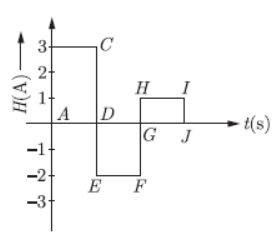
(a) 2 J
(b) 18 J
(c) 28 J
(d) 10 J
Answer
C
Question. 20 coulomb charge is flowing in 0.5 second from a point in an electric circuit then value of electric current in amperes will be
(a) 10
(b) 40
(c) 0.005
(d) 0.05
Answer
B
Question. A wire of resistance R is cut into ten equal parts which are then joined in parallel. The new resistance is
(a) 0.01 R
(b) 0.1 R
(c) 10 R
(d) 100 R
Answer
A
Question. A current of 4.8 A is flowing in a conductor. The number of electrons passing per second through the conductor will be
(a) 3×1020
(b) 76.8×1020
(c) 7.68×10-19
(d) 3×1019
Answer
D
Question. What is the current through a 5.0 ohm resistor if the voltage across it is 10 V
(a) zero
(b) 0.5 A
(c) 2.0 A
(d) 5.0 A
Answer
C
Question. The length of a wire is doubled. By what factor does the resistance change
(a) 4 time as large
(b) twice as large
(c) unchanged
(d) half as large
Answer
D
Question. How much work is done in moving a charge of 2 C from a point of 118 V to a point of 128 V?
(a) 20 J
(b) 30 J
(c) 40 J
(d) 10 J
Answer
A
Question. A 24 V potential difference is applied is applied across a parallel combination of four 6 ohm resistor. The current in each resistor is
(a) 1 A
(b) 4 A
(c) 16 A
(d) 36 A
Answer
B
Question. 100 J of heat is produced each second in a 4 Ω resistance. The potential difference across the resistor is
(a) 20 V
(b) 10 V
(c) 5 V
(d) 15 V
Answer
A
Question. Two unequal resistances are connected in parallel.
Which of the following statement is true
(a) current in same in both
(b) current is larger in higher resistance
(c) voltage-drop is same across both
(d) voltage-drop is lower in lower resistance
Answer
C
Question. A cylindrical rod is reformed to twice its length with no change in its volume. If the resistance of the rod was R, the new resistance will be
(a) R
(b) 2R
(c) 4R
(d) 8R
Answer
C
Question: A cylindrical conductor of length l and uniform area of cross-section A has resistance R. Anotherconductor of length 2 l and resistance R of the same material has area of cross-section:
(a) A/2
(b) 3 A/2
(c) 2 A
(d) 3 A
Answer
C
Assertion And Reason Based Questions :
(a) Both assertion (A) and reason (R) are true and reason (R) is the correct explanation of assertion (A).
(b) Both assertion (A) and reason (R) are true but reason (R) is not the correct explanation of assertion (A).
(c) Assertion (A) is true but reason (R) is false.
(d) Assertion (A) is false but reason (R) is true.
(e) Both Assertion and Reason are false.
Question. Assertion : If r 1 and r 2 be the resistivity of the materials of two resistors of resistances R1 and R2 respectively and R1 > R2 .
Reason : The resistance R = P,1/A ⇒ r1 > r2 if R1 > R2
Answer
C
Question. Assertion : Copper is used to make electric wires.
Reason : Copper has very low electrical resistance.
Answer
A
Question. Assertion : Silver is not used to make electric wires.
Reason : Silver is a bad conductor.
Answer
C
Question. Assertion : Wire A is thin in comparison to wire B of same material same length then resistance of wire A is greater than resistance of wire B.
Reason : Resistivity of wire A is greater than resistance of wire B.
Answer
C
Question. Assertion : A voltmeter and ammeter can be used together to measure resistance but not power.
Reason : Power is proportional to voltage and current.
Answer
E
Question. Assertion : A resistor of resistance R is connected to an ideal battery. If the value of R is decreased, the power dissipated in the circuit will increase.
Reason : The power dissipated in the circuit is directly proportional to the resistance of the circuit.
Answer
C
Question. Assertion : The 200 W bulbs glow with more brightness than 100 W bulbs.
Reason : A 100 W bulb has more resistance than 200 W bulb.
Answer
A
Question. Assertion : The resistivity of conductor increases with the increasing of temperature.
Reason : The resistivity is the reciprocal of the conductivity.
Answer
B
Question. Assertion : If a graph is plotted between the potential difference and the current flowing, the graph is a straight line passing through the origin.
Reason : The current is directly proportional to the potential difference.
Answer
A
Question. Assertion : The equation V = Ri does not apply to those conducting. devices which do not obey Ohm’s law.
Reason : V = RI is a statement of Ohm’s law.
Answer
C
Fill in the Blanks :
Question. ………….. is a property that resists the flow of electrons in a conductor.
Answer
Resistance
Question. The S.I. unit of resistance is ……………..
Answer
ohm (Ω)
Question. The potential difference across the ends of a resistor is …………… to the current through it, provided its ……………….. remains the same.
Answer
directly proportional, temperature
Question. The resistance of a conductor depends directly on its …………., inversely on its …………….., and also directly proportioned on the ………….. of the conductor.
Answer
length, area of cross-section, resistivity
Question. 1 volt × 1 coulomb = …………..
Answer
joule
Question. If there is no current, a voltmeter connected across a resistor will register………………… voltage.
Answer
zero
Question. Electrical power = (Potential difference)2/……….
Answer
Cresistance
Question. Electric energy is produced by the …….. of charges.
Answer
Separation
Question. Physical quantity represented by coulomb per second is ………. .
Answer
Electric current
Question. A fuse is connected in ………. to the ………. wire.
Answer
Series, live
Question. The alloy which is used for making the filament of bulbs is ………
Answer
Tungsten
Question. Power transmission is carried out at high ………. and low …….. .
Answer
Voltage, current
Question. Rate at which electric work is done is called ………
Answer
Electric power
Question. Copper is a preferred material for making wire because of its low ……….
Answer
Resistivity
Question. The electrical energy dissipated in a resistor is given by W = ……….
Answer
VxI xt
Question. The ………. reaction within the cell generates the potential difference between its two terminals that sets the ………. in motion to flow the current through a resistor.
Answer
chemical
Question. The resistance of a semiconductor …….. with increase in temp.
Answer
decreases
True / False :
Question. One kilowatt is equal to 10 horse power.
Answer
False
Question. The reciprocal of resistance is called specific
Answer
False
Question. The sun is visible two minutes before the actual sunrise due to atmospheric refraction.
Answer
True
Question. The focal length of a given lens depends on the surrounding medium.
Answer
True
Question. The resistivity of a wire is directly proportional to cross-sectional area.
Answer
True
Question. One kilowatt is equal to 10 horse power.
Answer
False
Question. The solar spectrum in general is an absorption spectrum.
Answer
False
Question. Ohm’s law is a relation between the power used in a circuit to the current and the potential difference.
Answer
False
Question. When a metallic conductor is heated the atoms in the metal vibrate with greater amplitude and frequency.
Answer
True
Question. The resistivity of all pure metals increases with the rise in temperature.
Answer
True
Question. In parallel combination, the reciprocal of equivalent resistance is the sum of the reciprocal of individual resistance.
Answer
True
Question. The resistance of a wire is directly proportional to area.
Answer
False
Question. When a metallic conductor is heated the atoms in the metal vibrate with greater amplitude and frequency.
Answer
True
Question. In parallel combination, the reciprocal of equivalent resistance is the sum of the reciprocal of individual resistance.
Answer
True
Question. The quantity of charge flowing through a point multiplied by time is a current.
Answer
False
Question. The resistance of a wire is directly proportional to length.
Answer
True
Match the Following :
Question. Column II gives name of material use for device given i column I
| Column I | Column II |
| (A) Resistance of resistance box | (p) R/2+6 |
| (B) Resistance between a and c | (q) 5/8 R |
| (C) Resistance between b and d r | (r) R |
Answer
A-q, B-r, C-p, D-s
Question.
| Column I | Column II |
| 1. Filament of electrical bulb | (a) Copper |
| 2. Heating elements | (b) Lead-tin alloy |
| 3. Connection wire | (c) Tungsten |
| 4. Fuse wire | (d) Nichrome |
Answer
1-(c), 2-(d), 3-(a), 4-(b)
Question.
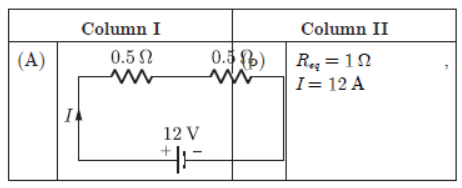
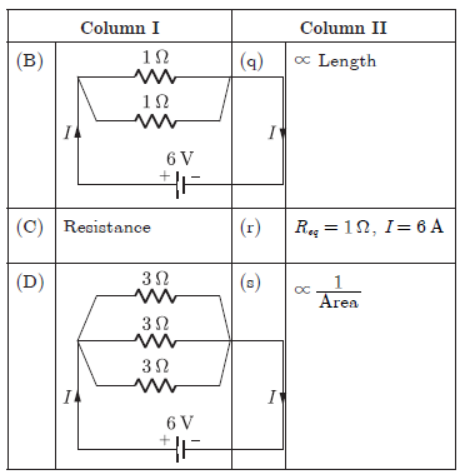
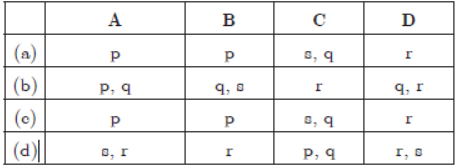
Answer
(a) A-p, B-p, C-s, q, D-r
Question.
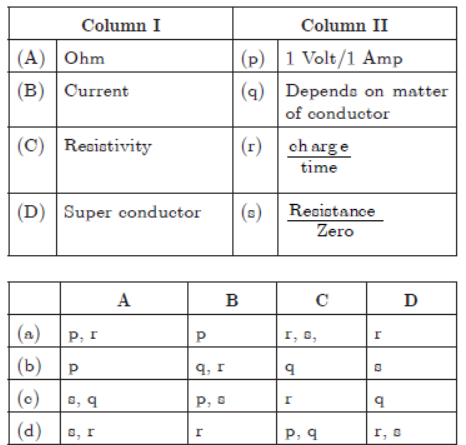
Answer
(b) A-p, B-q, r, C-q, D-s
Question. For the circuit shown in the adjoining figure, match the entries of column I with the entries of column II.
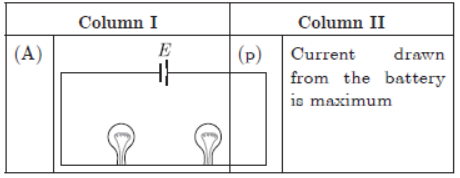
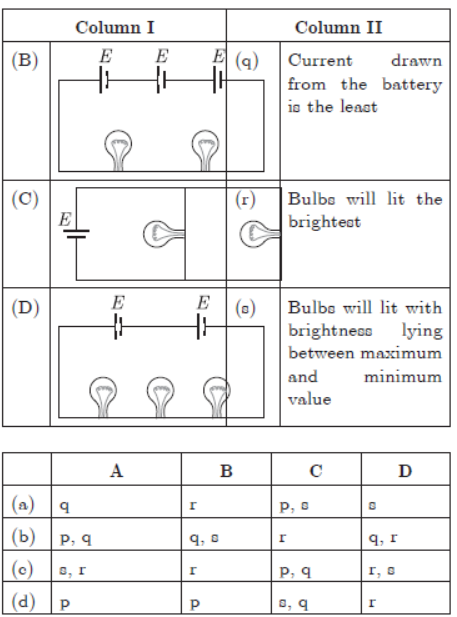
Answer
(a) A-q, B-r, C-p, s, D-s
Question.
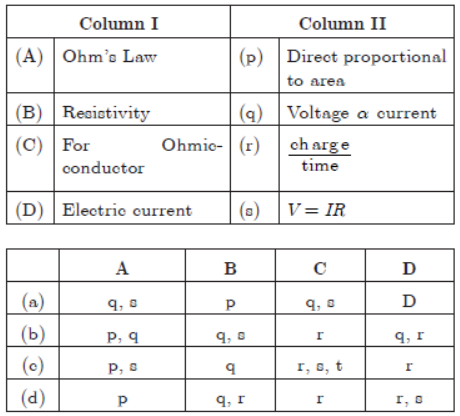
Answer
(a) A-q, s, B-p, C-q, s D-r
Question. In the figure shown, the value of each resistance is R. match the entries of column I with the entries of column II.

| Column I | Column II |
| (A) Resistance between a and b | (p) R/2 |
| (B) Resistance between a and c | (q) 5/8 R |
| (C) Resistance between b and d r | R |
Answer
A-q, B-p, C , D: r
Question. Consider a network of resistances each of value of R as shown in figure.
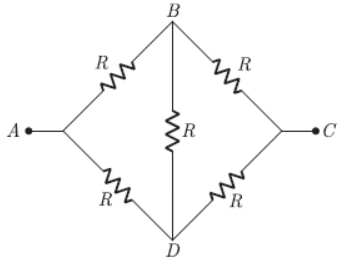
| Column I | Column II |
| (A) Equivalent of net work between A and C is | (p) same |
| (B) Equivalen t resistance between A and B | (q) 5/8 R |
| (C) Potential of B and D when voltage source is applied across A and C is | (r) R |
| (D) Potential of B and D when voltage source is applied across A and B is | (s) 2R |
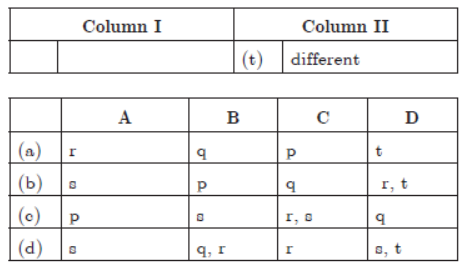
Answer
(a) A-r, B-q, C-p, D-t
Question. Match the Following
| Column I | Column II |
| (A) Ohm | (p) PL/A |
| (B) Resistance | (q) 1volt/1 ampere |
| (C) Resistivity | (r) zero resistance |
| (D) Super conductor | (s) ohm-meter |
Answer
A-q, B-p, C-s, D-r
Question.
| Column I | Column II |
| (A) Ohm | (p) ρL/A |
| (B) Resistance | (q) 1 volt/1 ampere |
| (C) Resistivity | (r) zero resistance |
| (D) Super conductor | (s) ohm-meter |
Answer
(A) → (q); (B) → (p); (C) → (s); (D) → (r)
Question. Column II gives name of material use for device given in column I
| Column I | Column II |
| (A) Resistance of resistance box | (p) tungsten |
| (B) Fuse wire | (q) maganin |
| (C) Bulb | (r) tin-lead alloy |
| (D) Insulator | (s) glass |
Answer
(A) → q; (B) → r; (C) → p; (D) → s

